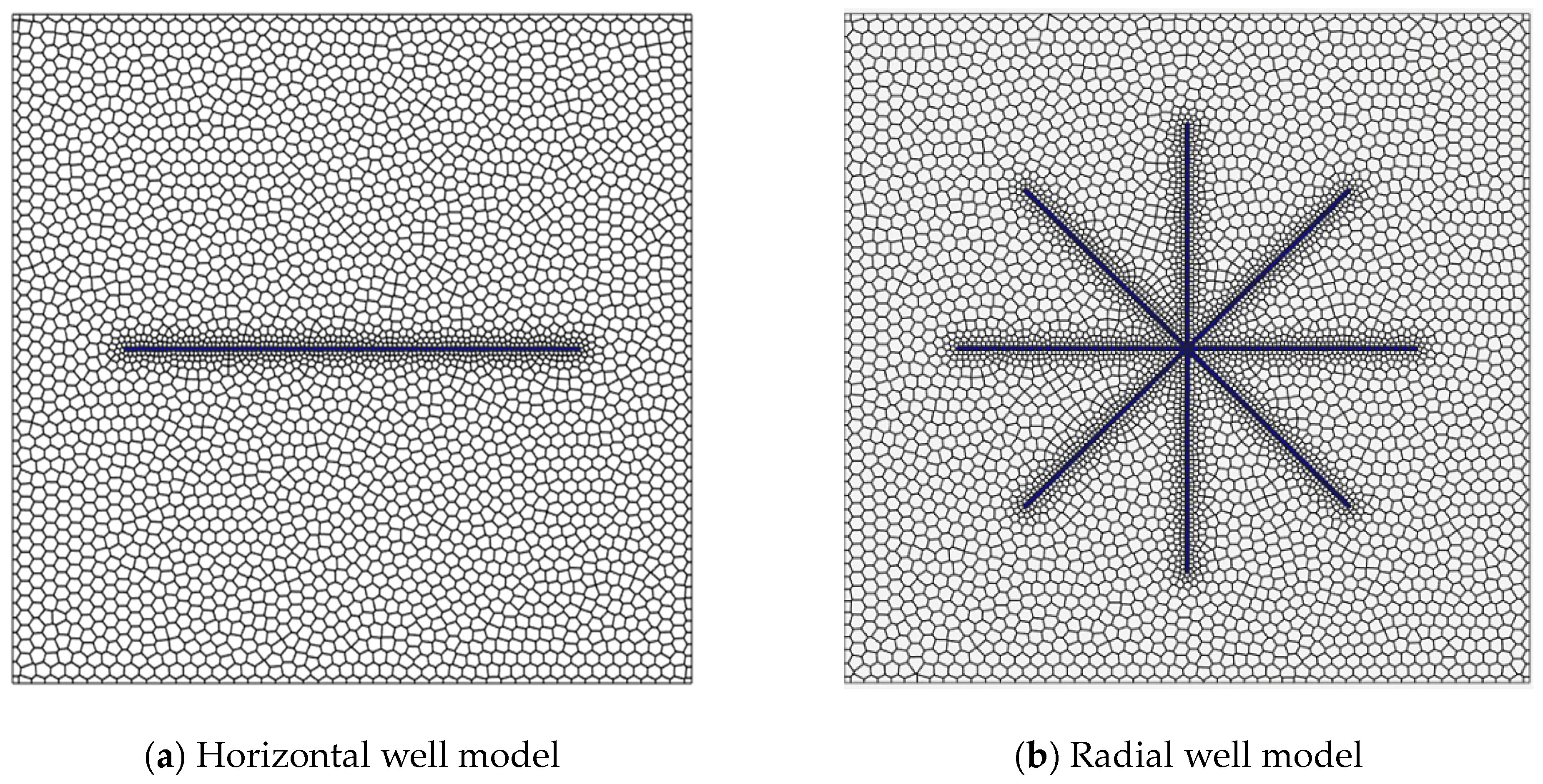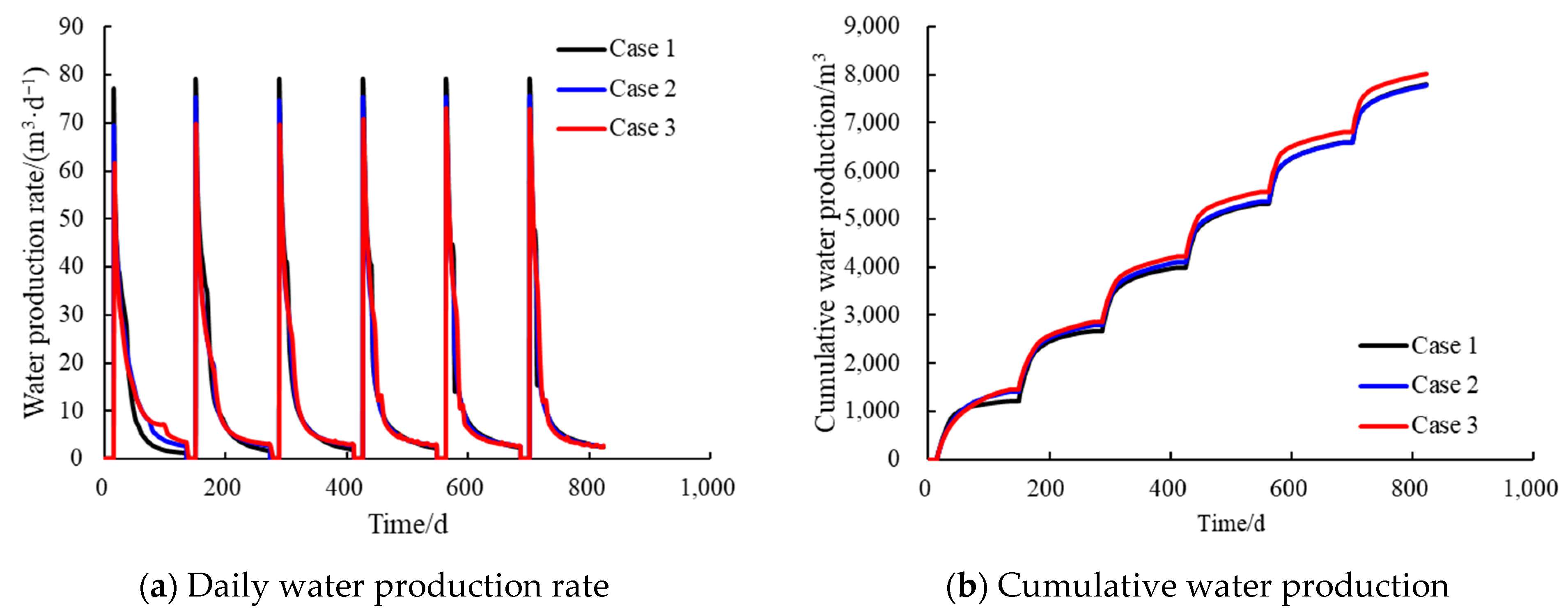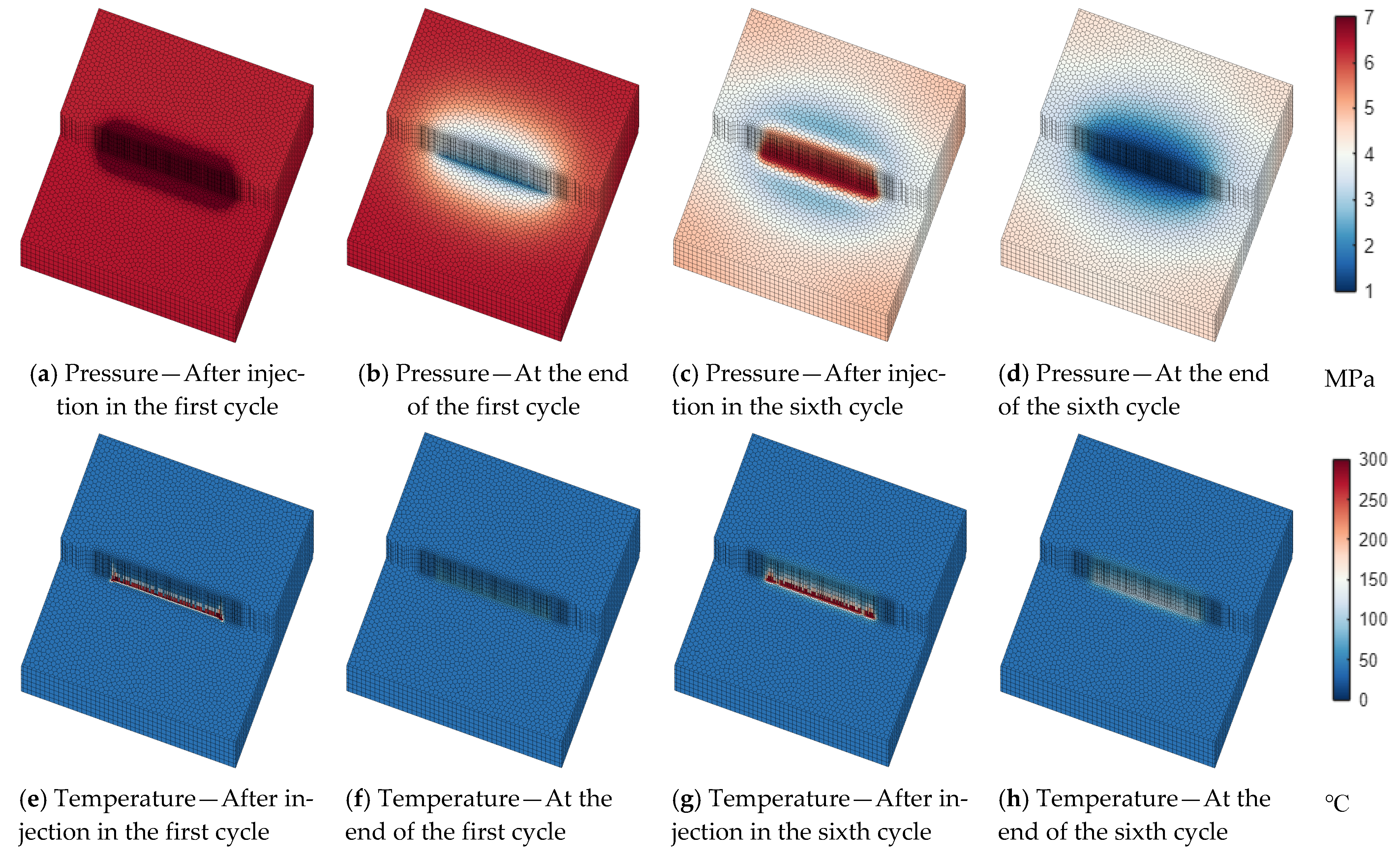A Numerical Simulation Method for Cyclic Steam Stimulation Development of Heavy Oil Reservoirs with Multi-Layer Radial Horizontal Wells
Abstract
1. Introduction
2. Methodology
2.1. Mathematical Model
2.1.1. Mass Conservation Equations
2.1.2. Energy Conservation Equation
2.1.3. Equations of State
2.1.4. Boundary Conditions
2.2. Model Solution
2.3. Model Validation
3. Case Study
3.1. Numerical Simulation Model Establishment
3.2. Production Dynamics Analysis
3.2.1. Oil and Water Production Analysis
3.2.2. Analysis of Physical Field Evolution
4. Discussion
- 1.
- The current work includes only a preliminary sensitivity analysis on the wellbore geometry (Cases 1–3). The impacts of key operational parameters and geological uncertainties were not investigated.
- 2.
- The validated model developed in this study provides a robust, high-fidelity tool. This opens avenues for important future research, such as simulating advanced hybrid processes (e.g., steam-solvent), generating reliable data for training AI-based surrogate models, and performing detailed economic and environmental impact analyses based on the accurate physical predictions [22,34].
- 3.
- This study focused on the thermo-hydraulic mechanism rather than economic feasibility. The 44.8% production gain shown for Case 3 is specific to our model parameters and must be weighed against the significantly higher drilling costs and operational risks of multi-layer radial drilling. A comprehensive techno-economic analysis, which would also include a detailed study of the technology’s performance under various steam override scenarios, is required before any field-scale deployment.
5. Conclusions
- (1)
- Based on unstructured grid technology, a numerical simulation method capable of accurately simulating the thermal recovery process of heavy oil with complex well types has been successfully established and validated in this study. This method uses PEBI unstructured grids to finely represent the geometry of radial well branches at any azimuth and level, effectively overcoming the limitations of traditional structured grids that are prevalent in many commercial simulators. Validation through comparison with the commercial software CMG demonstrates that the model’s calculation results are accurate and reliable, providing a powerful tool for in-depth research of radial well CSS technology.
- (2)
- The comparison of production dynamics for different well type scenarios shows that radial wells can significantly enhance the development effect of CSS. Compared with a conventional horizontal well, the final cumulative oil production of single-layer and dual-layer radial wells increased by 34.2% and 44.8%, respectively. Among the studied scenarios, the dual-layer radial well exhibited the highest peak production in each cycle and the highest final cumulative production, making it the optimal well type choice under the specific conditions and parameters investigated in this study.
- (3)
- The analysis of physical field evolution reveals the production enhancement mechanism of radial wells. Their core advantage lies in the wellbore structure, which greatly optimizes the efficiency of heat sweep in the plane. Compared to the linear, confined heating pattern along the wellbore of a horizontal well, a radial well forms a broader and more uniform radial heating zone by injecting steam through multi-directional branches. This allows for the mobilization of a larger reservoir volume, achieving more efficient energy utilization and crude oil recovery.
Supplementary Materials
Author Contributions
Funding
Data Availability Statement
Conflicts of Interest
References
- Wang, C.; Jin, H.; Fan, C.; Luo, K.; Guo, S. Exergy and energy analysis of coal gasification in supercritical water with external recycle system. Int. J. Chem. React. Eng. 2019, 17, 20190010. [Google Scholar] [CrossRef]
- Mokheimer, E.; Hamdy, M.; Abubakar, Z.; Shakeel, M.; Habib, M.; Mahmoud, M. A comprehensive review of thermal enhanced oil recovery: Techniques evaluation. J. Energy Resour. Technol. 2019, 141, 030801. [Google Scholar] [CrossRef]
- Zhang, J. Performance of high temperature steam injection in horizontal wells of heavy oil reservoirs. Energy 2023, 282, 128863. [Google Scholar] [CrossRef]
- Suranto, A.; Permadi, A.; Bae, W. Smart completion design in cyclic steam stimulation process: An alternative for accelerating heavy oil recovery. Int. J. Oil Gas Coal Technol. 2016, 11, 127–140. [Google Scholar] [CrossRef]
- Elkamel, L.; Sedaee, B. Influences of reservoir rock and fluid properties on cyclic steam stimulation efficiency in naturally fractured reservoirs. Int. J. Oil Gas Coal Technol. 2021, 28, 354–373. [Google Scholar] [CrossRef]
- Guo, K.; Li, H.; Yu, Z. In-situ heavy and extra-heavy oil recovery: A review. Fuel 2016, 185, 886–902. [Google Scholar] [CrossRef]
- Li, Y.; Wang, Z.; Hu, Z.; Xu, B.; Li, Y.; Pu, W.; Zhao, J. A review of in situ upgrading technology for heavy crude oil. Petroleum 2021, 7, 117–122. [Google Scholar] [CrossRef]
- Shah, A.; Fishwick, R.; Wood, J.; Leeke, G.; Rigby, S.; Greaves, M. A review of novel techniques for heavy oil and bitumen extraction and upgrading. Energy Environ. Sci. 2010, 3, 700–714. [Google Scholar] [CrossRef]
- Sun, F.; Yao, Y.; Li, X.; Yu, P.; Ding, G.; Zou, M. The flow and heat transfer characteristics of superheated steam in offshore wells and analysis of superheated steam performance. Comput. Chem. Eng. 2017, 100, 80–93. [Google Scholar] [CrossRef]
- Fan, J.; Li, X.; Qin, T. Feasibility study on steam and gas push with dual horizontal wells in a moderate-depth heavy oil reservoir. J. Eng. Sci. Technol. Rev. 2015, 9, 151–158. [Google Scholar] [CrossRef]
- Hou, J.; Zhou, K.; Zhao, H.; Kang, X.; Wang, S.; Zhang, X. Hybrid optimization technique for cyclic steam stimulation by horizontal wells in heavy oil reservoir. Comput. Chem. Eng. 2016, 84, 363–370. [Google Scholar] [CrossRef]
- Wang, B.; Huang, S.; Zhao, F.; Su, Z.; Fan, X.; Yang, M. Investigating the heated zone evolution and production performance of cyclic steam stimulation with horizontal well in thick-layer heavy oil reservoirs. Geoenergy Sci. Eng. 2024, 241, 213108. [Google Scholar] [CrossRef]
- Closman, P. Steam Zone Growth During Multiple-Layer Stream Injection. SPE J. 1967, 7, 1–10. [Google Scholar] [CrossRef]
- Satman, A. An analytical study of transient flow in stratified systems with fluid banks. In Proceedings of the SPE Annual Technical Conference and Exhibition, San Antonio, TX, USA, 4–7 October 1981. SPE-10264-MS. [Google Scholar] [CrossRef]
- Stanislav, F.; Easwaran, C.; Kokal, S. Interpretation of thermal well Falloff testing. SPE J. 1989, 4, 181–186. [Google Scholar] [CrossRef]
- Li, X.; Xiao, W.; Qu, Z.; Guo, T.; Li, J.; Zhang, W.; Tian, Y. Rules of fracture propagation of hydraulicfracturing in radial well based on XFEM. J. Pet. Explor. Prod. Technol. 2018, 8, 1547–1557. [Google Scholar] [CrossRef]
- Huang, Z.; Huang, Z.; Su, Y.; Bi, G.; Liu, X.; Jiang, T. A feasible method for the trajectory measurement of radial jet drilling laterals. SPE Drill. Complet. 2020, 35, 125–135. [Google Scholar] [CrossRef]
- Bruni, M.; Biasotti, H.; Salomone, G. Radial Drilling in Argentina. In Proceedings of the Latin American & Caribbean Petroleum Engineering Conference, Buenos Aires, Argentina, 15–18 April 2007. SPE-107382-MS. [Google Scholar] [CrossRef]
- East, L.E., Jr.; Grieser, W.; McDaniel, B.; Johnson, B.; Jackson, R.; Fisher, K. Successful Application of Hydrajet Fracturing on Horizontal Wells Completed in a Thick Shale Reservoir. In Proceedings of the SPE Eastern Regional Meeting, Charleston, WV, USA, 15–17 September 2004. SPE-91435-MS. [Google Scholar] [CrossRef]
- Gu, M.; Sheng, M.; Zhang, B.; Tian, S.; Li, G. Local Stress Reconstruction of Multi Radial Wells for Enhancing Stimulated Height of Shale Oil Reservoir. Rock Mech. Rock Eng. 2024, 57, 10673–10693. [Google Scholar] [CrossRef]
- Liu, X.; Han, Z.; Yu, L.; Wei, W.; Lu, H.; Sun, Y. Hydrate Reservoir Stimulation and Sand Control by Liquid-Solid Phase Change Proppant Filled in Radial Well. SPE J. 2023, 28, 2003–2020. [Google Scholar] [CrossRef]
- Sun, H.; Wang, H.; Cao, X.; Shu, Q.; Fan, Z.; Wu, G.; Yang, Y.; Wu, Y. Innovations and applications of the thermal recovery techniques for heavy oil. Energy Geosci. 2024, 5, 100332. [Google Scholar] [CrossRef]
- Li, P.; Wang, X.; Zhang, Y. Thermal recovery of heavy oil reservoirs: Modeling of flow and heat transfer characteristics of superheated steam in full-length concentric dual-tubing wells. Geoenergy Sci. Eng. 2025, 244, 213432. [Google Scholar] [CrossRef]
- Wang, F.; Kobina, F. The Influence of Geological Factors and Transmission Fluids on the Exploitation of Reservoir Geothermal Resources: Factor Discussion and Mechanism Analysis. Reserv. Sci. 2025, 1, 3–18. [Google Scholar] [CrossRef]
- Li, Q. Reservoir Science: A Multi-Coupling Communication Platform to Promote Energy Transformation, Climate Change and Environmental Protection. Reserv. Sci. 2025, 1, 1–2. [Google Scholar] [CrossRef]
- Liu, Y.; Hou, J.; Zhao, H.; Liu, X.; Xia, Z. A method to recover natural gas hydrates with geothermal energy conveyed by CO2. Energy 2018, 144, 265–278. [Google Scholar] [CrossRef]
- Li, Y.; Wu, N.; Gao, D.; Chen, Q.; Liu, C.; Yang, D.; Jin, Y.; Ning, F.; Tan, M.; Hu, G. Optimization and analysis of gravel packing parameters in horizontal wells for natural gas hydrate production. Energy 2021, 219, 119585. [Google Scholar] [CrossRef]
- Guo, T.; Hao, T.; Chen, M.; Zhang, Y.; Qu, Z.; Jia, X.; Zhang, W.; Yu, H. Numerical simulation on Geothermal extraction by radial well assisted hydraulic fracturing. Renew. Energy 2023, 210, 440–450. [Google Scholar] [CrossRef]
- He, J. Numerical simulation of a Class I gas hydrate reservoir depressurized by a fishbone well. Processes 2023, 11, 771. [Google Scholar] [CrossRef]
- Wang, R.; Lei, Z.; Han, J.; Yang, Y.; Yan, Y. Complex fracture description and quasi-elastic energy development mathematical model for shale oil reservoirs. Front. Energy Res. 2024, 12, 1407183. [Google Scholar] [CrossRef]
- IAPWS-IF97; Industrial Formulation 1997 for the Thermodynamic Properties of Water and Steam. International Association for the Properties of Water and Steam (IAPWS): Erlangen, Germany, 1997.
- Peaceman, D. Interpretation of well-block pressures in numerical reservoir simulation with nonsquare grid blocks and anisotropic permeability. SPE J. 1983, 23, 531–543. [Google Scholar] [CrossRef]
- Liu, H.; Chen, Z. A scalable thermal reservoir simulator for Giant models on parallel computers. arXiv 2018, arXiv:1812.03952. [Google Scholar] [CrossRef]
- Jin, B.; Xu, X. Price forecasting through neural networks for crude oil, heating oil, and natural gas. Meas. Energy 2024, 1, 100001. [Google Scholar] [CrossRef]











| Parameter | Value | Parameter | Value |
|---|---|---|---|
| Reservoir depth/m | 600 | Initial water saturation | 0.25 |
| Pay zone thicknessm | 20 | Initial oil saturation | 0.75 |
| Overburden thickness/m | 30 | Thermal conductivity of water/(W·m−1·K−1) | 0.62 |
| Underburden thickness/m | 30 | Thermal conductivity of oil/(W·m−1·K−1) | 0.13 |
| Porosity | 0.3 | Thermal conductivity of gas/(W·m−1·K−1) | 0.0016 |
| Planar permeability/(mD) | 1000 | Thermal conductivity of rock/(W·m−1·K−1) | 1.73 |
| Vertical permeability/(mD) | 200 | Oil density/(kg·m−3) | 975 |
| Rock heat capacity/(J·m−3·K−1) | 2.35 × 106 | Initial reservoir temperature/°C | 38 |
| Rock compressibility/(Pa−1) | 8.5 × 10−9 | Initial oil viscosity/(mPa·s) | 2000 |
| Rock thermal expansion coefficient/(K−1) | 9.0 × 10−5 | Connate water saturation | 0.25 |
| Initial pressure/MPa | 6 | Residual oil saturation | 0.2 |
Disclaimer/Publisher’s Note: The statements, opinions and data contained in all publications are solely those of the individual author(s) and contributor(s) and not of MDPI and/or the editor(s). MDPI and/or the editor(s) disclaim responsibility for any injury to people or property resulting from any ideas, methods, instructions or products referred to in the content. |
© 2025 by the authors. Licensee MDPI, Basel, Switzerland. This article is an open access article distributed under the terms and conditions of the Creative Commons Attribution (CC BY) license (https://creativecommons.org/licenses/by/4.0/).
Share and Cite
Yu, T.; Zhang, Z.; Li, Y.; Liu, Y.; Li, A.; Chen, D.; Chen, L. A Numerical Simulation Method for Cyclic Steam Stimulation Development of Heavy Oil Reservoirs with Multi-Layer Radial Horizontal Wells. Processes 2025, 13, 3694. https://doi.org/10.3390/pr13113694
Yu T, Zhang Z, Li Y, Liu Y, Li A, Chen D, Chen L. A Numerical Simulation Method for Cyclic Steam Stimulation Development of Heavy Oil Reservoirs with Multi-Layer Radial Horizontal Wells. Processes. 2025; 13(11):3694. https://doi.org/10.3390/pr13113694
Chicago/Turabian StyleYu, Tiantian, Zhaoxiang Zhang, Yipu Li, Yongge Liu, Aifen Li, Dechun Chen, and Liyuan Chen. 2025. "A Numerical Simulation Method for Cyclic Steam Stimulation Development of Heavy Oil Reservoirs with Multi-Layer Radial Horizontal Wells" Processes 13, no. 11: 3694. https://doi.org/10.3390/pr13113694
APA StyleYu, T., Zhang, Z., Li, Y., Liu, Y., Li, A., Chen, D., & Chen, L. (2025). A Numerical Simulation Method for Cyclic Steam Stimulation Development of Heavy Oil Reservoirs with Multi-Layer Radial Horizontal Wells. Processes, 13(11), 3694. https://doi.org/10.3390/pr13113694





